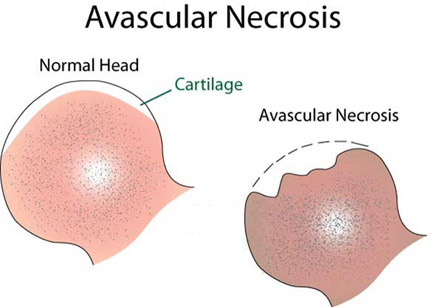Avascular Necrosis
Introduction
Avascular necrosis is also called as Osteonecrosis, Ischemic bone necrosis or AVN. It is a bone death caused by deranged supply of blood to that area. Most common locations of avascular necrosis are hip and shoulder, but other large joints like knee, elbow, wrist and ankle may also be affected.
Causes, incidence, and risk factors for avascular necrosis:
In early stages of the disease, usually there are no symptoms.
AVN occurs when a part of the bone does not get blood supply and dies. If untreated, the bone can collapse and the joint deteriorates over time. This can lead to severe arthritis if left alone.
This necrosis can be caused by a disease or severe injury like break or dislocation causing reduction of blood supply to bone. But, sometimes no apparent reason seems to be present. Then it is called as idiopathic osteonecrosis. Idiopathic means it occurs without any known cause.
Iran ranks among the top 10 countries in orthopedics and Iranian surgeons perform high quality orthopedic surgeries at highly affordable prices

The following causescan lead to osteonecrosis:
1. Steroid treatment for long period
2. Excessive alcohol intake
3. Radiation therapy
4. Sickle cell anemia
5. Gaucher’s disease
6. Caisson’s disease or decompression sickness
7. Fracture or dislocation around the joint
8. Some other diseases postulated to be associated with this condition are diabetes, gout, and atherosclerosis.
Affection of shoulder joint usually occurs due to long-term treatment with steroids or a history of injury to the shoulder. Another similar condition found in children and adolescents is called as Legg-Calvé-Perthes disease.
Symptoms:
In early stages of the disease, usually there are no symptoms. As the necrosis progresses, following symptoms can occur:
1. Pain in the joint- it increases progressively and becomes very severe after the collapse of bone. It occurs even at rest.
2. Limitation in the range of motion of the joint
3. Groin pain in case of hip joint affection
4. Limping or difficulty in walking in AVN of femur
Signs and tests:
The orthopedic surgeon first asks thoroughly about the symptoms and previous medical history. The questions are directed to find out:
1. Beginning of pain
2. Radiation of pain anywhere from the starting point
3. Severity of pain at rest or during night
4. Extent of reduction in joint motion
5. Relief of pain on analgesic treatment
6. Treatment with steroids for any cause and duration of treatment
7. Alcohol drinking history including duration and quantity
8. Any history of medications or vitamin supplements
After history, a thorough physical examination of the patient is done to find out any diseases or conditions that can affect the bones.
Then, after the examination, the surgeon can order one or more of the following tests:
1. X-ray
2. MRI
3. Bone scan
4. CT scan
Treatment:
If the orthopedic surgeon knows the reason for avascular necrosis, part of the treatment is directed at the underlying root cause. For example, if a blood clotting disorder is the reason; clot-dissolving medications may help to a great extent.
Non-surgical or conservative treatment can slow the progression of the disease, but eventually surgery is required in most patients. This includes:
1. Early diagnosis of the disease by screening the high risk patients.
2. Use of various highly selective pain relievers
3. Limitation of use of the affected joint
4. Use of crutches in hip, knee, or ankle affection
5. Exercises and physiotherapy to increase the range of motion of the diseased joint.
Surgical options for the disease are:
1. Bone grafting
2. Grafting of bone along with its blood supply (vascularized bone graft)
3. Cutting and alignment of bone in such a way to relieve the stress on the bone or joint (osteotomy)
4. Total joint replacement
5. Removal of a part of bone core to relieve pressure on the bone resulting in formation of new blood vessels.
Expectations (prognosis) in AVN
The outcome of the disease can be anything between complete healing and permanent damage of the involved bone. It depends on various factors like:
1. The root cause of the avascular necrosis
2. Stage and duration of disease
3. Extent of bone involvement
4. Age and general health of the patient
If the disease progresses, it can lead to severe osteoarthritis and permanent decreased mobility of the joint. Severe cases may require joint replacement.
Prevention:
Many cases of osteonecrosis occur without a known cause. Therefore, prevention may not be possible. However, the risk reduction can be done by exercising precautions such as:
1. Avoid alcohol drinking excessively
2. If feasible, avoid high doses and long-term use of corticosteroids.
3. Safe diving techniques to avoid decompression sickness.